The first part of phase two’s hearings concluded last week - here’s an overview of the evidence revealing major failures, incompetence and buck-passing
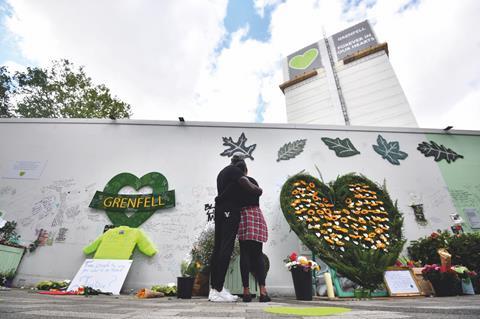
‘Going into people’s homes and ripping out the entire wall finish was just an unimaginable amount of disruption,” Andrew McQuatt told the Grenfell Tower inquiry one morning in September.
McQuatt, a project engineer at consultant Max Fordham and part of the original Grenfell refurbishment team, said the idea of insulating the insides of Grenfell’s exterior walls to improve the thermal efficiency of the block was “very quickly discounted” in 2012 in favour of overcladding.
Five years and £10m of regeneration work later, the highly combustible aluminium composite material cladding and flammable insulation added to the 24-storey west London block would catch fire, delivering catastrophic disruption, claiming 72 lives and shattering hundreds more.
The story of Grenfell Tower’s overcladding would be a comedy of errors were it not for the horror of what happened on that night of 14 June 2017 and the long-lingering pain of its aftermath.
The official probe into the disaster has just finished examining the role played by contractors, consultants, project client Kensington and Chelsea Tenant Management Organisation (KCTMO) and the Royal Borough of Kensington and Chelsea’s (RKBC) building control department. The inquiry’s chair, Sir Martin Moore-Bick, and his panel still have more than a year of evidence left to feed into their Phase Two report on the root causes of the fire.
But cutting through the buck-passing in the just-concluded “module one” hearings, construction industry professionals can take some lessons from the evidence of firms and the inquiry’s expert advisers.
Focusing on the role of design-and-build main contractor Rydon Maintenance Ltd and its interactions with key members of the project team and its advisers is as good a viewpoint as any from which to do that.
In the beginning
Project client KCTMO began work on the Grenfell refurbishment in 2012, bringing in contractor Leadbitter, architect Studio E, M&E consultant Max Fordham, fire consultant Exova and Artelia – then known as Appleyards – as employer’s agent, QS and CDM co-ordinator. All were working on RBKC’s neighbouring Kensington Academy and Leisure Centre (KALC). The worked-up Grenfell proposals also introduced new flats at the block’s lower levels, relocated existing office space and a boxing club, improved facilities at a nursery and upgraded the tower’s heating system.
Leadbitter fell out of favour in the first half of 2013, despite cutting its price for the works from £12.1m to £10.0m. An OJEU procurement process saw Rydon Maintenance Ltd come in cheapest at £9.2m, beating rival contractor Durkan’s £9.9m price and Mulalley’s £10.4m bid. Rydon was confirmed as preferred main contractor in March 2014 after a secret meeting with KCTMO agreed a further £800k in savings would be found to match the actual project budget.
> Grenfell Tower: A lesson in how not to manage a project
Studio E was novated to Rydon and the main contractor appointed facades subcontractor Harley to design and deliver the building’s new cladding system: the cassette version of Alcoa’s Reynobond PE 55 ACM with Celotex RS5000 insulation behind it. The insulation was fundamentally the same as the Celotex FR5000 listed in the NBS statement in the tender documents. The product was proposed by Max Fordham’s McQuatt in 2012 because of its thinness and ability to deliver “aspirational” thermal efficiency targets. Its fire performance was never properly scrutinised by any team members. Reynobond ACM had been included on the NBS specification as a potential alternative to Studio E’s proposed zinc-skinned Proteus HR honeycomb rainscreen panels. KCTMO’s need for value-engineering savings made switching to cheaper rainscreen options an obvious step.
There are many items which need looking at by our proposed construction team, and therein lies the problem: we don’t fucking have one!! To say I’m concerned about this is an understatement
Email from Harley commercial manager Mark Harris to Harley contracts manager Rob Maxwell in June 2014
According to the inquiry‚Äôs Phase One report, the cladding combination added to Grenfell ‚Äúactively promoted‚Äù the spread of fire instead of ‚Äúadequately resisting‚Äù it, as demanded by Requirement B4(1) of Schedule 1 to the ∫√…´œ»…˙TV Regulations 2010 (see ‚ÄúFatally flawed cladding‚Äù, below).
During evidence sessions in July, senior Rydon officials repeatedly stressed they relied on their specialist advisers to make sure the products used in the refurbishment complied with ∫√…´œ»…˙TV Regulations and that they were installed properly.
Original Grenfell contracts manager Simon Lawrence told the inquiry the business “would not be able to check to the technical detail” of proposals in-house. “We employed specialist designers that should have been designing and installing to the regs,” he said. “It was then checked by not only an independent clerk of works but it was also checked by building control.”
Fatally flawed cladding
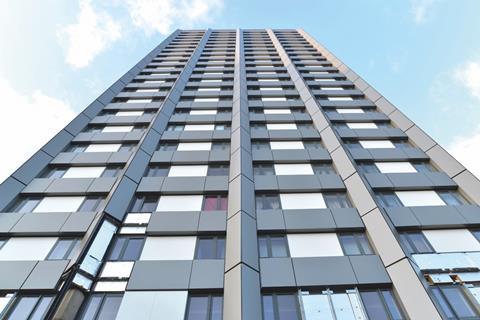
The Grenfell Tower Inquiry has already found that fire spread so rapidly around the block on 14 June 2017 because the newly fitted ACM rainscreen panels with polyethylene (PE) cores “acted as a source of fuel”. Combustible polyisocyanurate (PIR) and phenolic foam insulation boards behind the ACM “contributed to the rate and extent of vertical flame spread” and components of the window surrounds may also have done. Cavity barriers designed to restrict the spread of fire as part of Grenfell’s new external envelope were either missing or so badly installed that they could not do their job.
Fire-safety expert witness Dr Barbara Lane described the ACM and insulation as “terrible material”. Reynobond PE 55 ACM was introduced to the project as a value-engineering move when Rydon became main contractor. Project architect Studio E had favoured zinc cladding but the NBS specification for the refurbishment asked prospective main contractors to provide quotes for alternatives to zinc. One was Reynobond Duragloss 5000 in either cassette or face-fixed form.
Celotex FR5000 PIR insulation was originally proposed for the tower by a consultant at Max Fordham in 2012. Thinness and thermal efficiency were the drivers, not fire safety. Celotex RS5000 – fundamentally the same product – was installed on Grenfell. Its suitability was never properly interrogated by any project team member or RBKC building control. Combustible phenolic insulation Kingspan Kooltherm K15 was installed on Grenfell when Celotex was not available.
Contractor SD Plastering used Celotex TB4000 insulation and Kingspan Thermapitch TP10 insulation boards to pack out the extended window reveals, finished with uPVC panels. The plan was decided jointly with Rydon.
Inquiry expert witness on architecture Paul Hyett said Studio E “simply failed” to produce the proper amount of design work before the project was tendered and that it “entered production stage, with inadequate design and specification work”. He said that after it was novated to Rydon, Studio E had tried to offload some of its design responsibilities to Harley.
I had enough. I wasn’t able to do the job how I was trained to do and it was affecting my health. I just decided that I didn’t want to work there anymore
RBKC building control surveyor John Hoban on why he quit the authority in March 2017. Hoban said he had a caseload of around 130 projects to oversee at the time of the Grenfell refurbishment
Hyett said an “ongoing major failure” on the part of Studio E was not recognising that Celotex PIR insulation was unsuitable for Grenfell (see “What the experts said”, below). He said that issue and the non‑compliance of Reynobond PE 55 should have been picked up by routine design reviews the architect and Rydon were supposed to be conducting under their ISO 9001 quality-management registration.
Rydon and Harley had worked together on tower block overcladding projects before, but Harley had lost technical expertise through staff changes. One of Hyett‚Äôs reports said the firm ‚Äúclearly did not understand‚Äù the requirements of the ∫√…´œ»…˙TV Regulations and produced ‚Äúfundamentally flawed‚Äù detailed design work.
Former Rydon commercial manager Zak Maynard told the inquiry in September that the firm had struggled to find cladding contractors other than Harley who were interested in taking on the Grenfell job. Meanwhile Harley struggled to pull together a team for the job.
Hyett said he would have expected an experienced design and build contractor such as Rydon to have checked drawings produced by its architect and subcontractors and to have raised queries on any errors or omissions. But he “found little evidence” that it did.
“I am surprised that Rydon did not routinely spot many of the serious omissions and errors contained in the drawings,” he said.
Shirking responsibilities
Hyett added that Rydon’s failure to establish a matrix of responsibilities for the project team was a crucial problem that allowed Studio E to shirk some of its responsibilities. He also said a “competent and responsible” design and build contractor would have insisted on the creation of a “tracker” to manage and co-ordinate the staged submission of documents to RBKC’s building control officers.
I do not think I have ever worked with a contractor operating with this level of nonchalance
Internal email in 2016 from Neil Reed of Artelia to the firm’s project lead for Grenfell, Simon Cash, complaining about Rydon’s perceived dwindling commitment to the project’s final stages
But Hyett said the way that the process was actually handled had been a “shambles” of submissions that were “inadequately prepared, ill co-ordinated and incomplete”, which would have made it harder for building control officers to do their jobs. RBKC building control surveyor John Hoban told the inquiry he was overworked at the time of the Grenfell project and could not devote as much time to the Grenfell refurbishment as he wanted. But Hoban said he “had a confidence in the architects and the other professionals and Exova” because of their work on the neighbouring KALC project.
The inquiry also heard that the independent clerk of works responsible for checking Grenfell’s new external envelope, Jonathan White of John Rowan & Partners, only conducted weekly inspections and was “not specifically” evaluating design compliance.
Stephen Blake, Rydon’s refurbishment director at the time of the Grenfell refurbishment, was quizzed about the firm’s decision not to hire fire-safety consultant Exova as a full member of the project team. Blake said it had been Studio E’s responsibility to arrange – and pay for – any specialist fire safety advice it needed. Exova continued to advise the project on an ad-hoc basis and billed KCTMO, but the quality of its work has been strongly criticised by expert fire safety witness Dr Barbara Lane (see “What the experts said”, below).
What the experts said
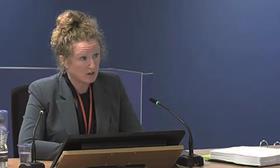
Fire safety: Arup director Dr Barbara Lane said fire-safety consultant Exova’s advice to the project team had been “entirely inadequate”. Lane said Exova’s suggestion in a key document that the proposed works would have “no adverse effect” on external fire spread – at the same time as failing to analyse the proposals or identify that overcladding was involved – was “very serious evidence of professional negligence”. She rejected the firm’s suggestion it was excluded from the project team after Rydon became main contractor.
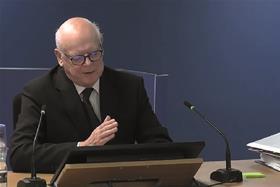
Architecture: RIBA past president Paul Hyett criticised Studio E‚Äôs ‚Äúongoing major failure‚Äù not to recognise that Celotex PIR insulation was unsuitable for Grenfell and said the practice lacked the experience to design a high-rise overcladding project without its own specialist fire consultant. He said Studio E also failed to deliver important design and specification work both before and after being novated to Rydon. Hyett said facades specialist Harley ‚Äúclearly did not understand‚Äù ∫√…´œ»…˙TV Regulations requirements and Rydon was not proactive enough in managing its contractors and consultants.
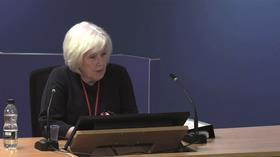
∫√…´œ»…˙TV control: Consultant Beryl Menzies said the project team‚Äôs full plans application to RBKC lacked sufficient information to demonstrate compliance with ∫√…´œ»…˙TV Regulations and should have been rejected. She said it was a ‚Äúfundamental failing‚Äù not to request further information about the proposed cladding system or carry out an in-depth review of its suitability. Menzies said building control officer John Hoban seemingly ‚Äúrelied on the unsubstantiated word of the contractors‚Äù that the system met requirements.
Cavalier attitude
Hyett said Rydon‚Äôs decision not to appoint Exova or another specialist fire consultant suggested a ‚Äúcavalier attitude‚Äù to fire safety or a fundamental lack of understanding of the complexity of ∫√…´œ»…˙TV Regulations requirements for overcladding works. Studio E and Artelia were also criticised for failing to recognise more fire-safety expertise was needed.
Elsewhere in Rydon’s evidence, it emerged that the firm had miscalculated its winning bid price for Grenfell by £212,000. It sought to hold back some of the value-engineering savings delivered by the switch from zinc cladding to ACM and to save money by ditching a plan for the new window reveals of Grenfell’s flats to be lined with wood. Instead, the gaps around the windows were packed with combustible insulation and lined with uPVC.
This was a traditional […] design and build contract that seemed very straightforward and very ordinary in many ways, and that it’s ended up in this tragedy is just devastating
KCTMO director of assets and regeneration Peter Maddison’s hindsight reflections to the inquiry
Towards the end of the module one hearings, the inquiry heard that a member of the KCTMO executive board and one of its legal advisers had questioned whether Rydon’s £9.2m bid had been unrealistically low, even before the client sought a further £800,000 in savings.
KCTMO director of assets and regeneration Peter Maddison said the bid had been evaluated by Artelia, which had raised no concerns, and Rydon had delivered the project on budget.
Inquiry lead counsel Richard Millett QC responded: “If I may say so, the fact that the project was delivered on budget is not of great assistance to us, given that we know what happened to the building.”
Surprising revelations
- Project architect Studio E had no experience of working on high-rise residential buildings. It was hired for Grenfell Tower because it was seen as having done a good job on RBKC’s neighbouring Kensington Academy and Leisure Centre project.
- Combustible Celotex PIR insulation was proposed for Grenfell because mineral wool, the “go-to” choice for such projects, would have needed to be too thick for the design to accommodate to meet “aspirational” thermal-efficiency targets. Fire performance was not considered.
- Harley Facades struggled to assemble a Grenfell team and ended up appointing the 25-year-old son of company boss Ray Bailey as project manager and describing freelance draughtsman Kevin Lamb as “project designer”.
- Former Harley technical manager Daniel Anketell-Jones said there was a window of almost three years when the firm did not have anyone qualified to check the fire performance of materials. He did not believe even a “cursory examination” was conducted on the cladding specified for Grenfell.
- KCTMO regeneration director Peter Maddison admitted compromising the OJEU procurement process for the refurbishment main contractor by arranging a secret meeting with Rydon to discuss the need for value-engineering savings if the firm was selected. “I wouldn’t call it improper,” he said.
- KCTMO project manager Claire Williams “binned” all but one of her notebooks covering the years she worked on the Grenfell Tower refurbishment a year after the fire.
- Hard-copy files relating to the refurbishment were found to be missing from the Royal Borough of Kensington and Chelsea’s building control records after the fire.
- Daniel Anketell-Jones deleted all company files – including those related to Grenfell – from his Harley laptop on his last day with the firm in March 2016. He thought the information would be retained on the company server.
- Cladding fitters Mark Osborne and Grahame Berry invoiced Harley £880 for a day when eight men were paid to look like they were working, even though there was nothing to do, because Rydon was showing a prospective client around the site. They admitted the quality of some of their firm’s cavity-barrier fitting was “shocking” and “unacceptable”.
Earlier, the inquiry heard that when Artelia director of cost management Simon Cash was told Rydon had bid £9.2m he responded “Good result, what did they miss?” in an email to project QS Chweechen Lim.
At the end of his evidence, expert witness on architecture Hyett set out fears that the growth of design and build procurement was pushing risk “downstream” onto insufficiently trained subcontractors, leading all too often to “design and technical failure”.
He said design and build contracts also allowed far more swapping-out of products than traditional contracts and put pressure on timing and sequencing of projects that had potential consequences for quality.
Because we came so late to the party, we have assumed that everybody else has already run every scenario and got it right
Mark Dixon of SD Plastering on why he never asked Rydon for a proper specification for the window surrounds of Grenfell’s flats. They were packed with combustible insulation and trimmed with uPVC
Hyett’s report said one question for the construction industry prompted by the Grenfell disaster was over safeguards to ensure critically important work was checked by properly trained and regulated people. Another area of “critical importance” was ensuring that people undertaking inspections understood what they were checking.
Studio E went into voluntary liquidation in April. But its staff, as well as Rydon, Artelia, Harley, Exova, Max Fordham and all the other firms involved, will have to wait until mid-2022 – by current estimates – to find out how the inquiry’s phase-two report apportions blame and recommends change in the construction industry.
Readers of ∫√…´œ»…˙TV‚Äôs extensive day-by-day module-one coverage can draw their own conclusions on the conduct of key players in the refurbishment.
Module two is now looking at the products used in the project, including their testing, certification and the claims made in marketing literature. Hearings are set to continue into 2022.
Grenfell inquiry timeline
2017
The public inquiry into the Grenfell Tower fire was announced by then prime minister Theresa May one day after the tragedy in June 2017 and has been broken down into two phases.
2018
Chaired by former Lord Justice of Appeal Sir Martin Moore-Bick, the first phase focused on the events of the night of the fire on 14 June, finishing in December 2018 before phase one recommendations were published in October 2019
January 2020
The second phase began with module one in the last week of January, with the focus on determining responsibility for the design and delivery of the 2012-16 refurbishment that clad the tower in flammable materials.
Phase two has eight modules in total, of which the first concluded last week. The final one – including a final round-up of evidence from expert witnesses – is expected in early 2022
February
The start of phase two was almost immediately delayed by witnesses requesting assurances the evidence they gave to the trial would not be used in future criminal prosecutions against them.
Most of February was lost to legal arguments, but at the end of the month the attorney general, Suella Braverman, confirmed that anything said by witnesses would not be used to prosecute them over the fire.
March
The inquiry resumed, but after hearing evidence from fire-safety specialist Exova and the architect on the scheme, Studio E, the covid-19 pandemic caused the abrupt suspension of the hearing in the middle of the month when the prime minister announced non-essential contact must be avoided.
July
The inquiry started up a second time before a halt was called at the end of the month for a summer break. Rydon gave much of its evidence before the break
September
The inquiry heard more evidence from main contractor Rydon, followed by facades specialist Harley and cladding installer Osborne Berry, with witnesses from consultants including QS Artelia, M&E specialist Max Fordham and clerk of works John Rowan & Partners also giving evidence
October
The module finished with witnesses appearing from RBKC and KCTMO, before a series of expert witnesses including Arup director Dr Barbara Lane and former RIBA president Paul Hyett
November
The second module began last week with the next group under the spotlight being the product manufacturers.
As well as Moore-Bick, the inquiry panel includes Thouria Istephan, a partner at Foster + Partners and a deputy of technical design at the firm, and the chief executive of a Leeds housing association.
Ali Akbor replaced former panel member Benita Mehra, who resigned in January over her links to Arconic, the manufacturer of the cladding that was used on the Grenfell Tower refurbishment.
Mehra was herself a replacement for the panel’s original third member, Nabeel Hamdi, who resigned without explanation last December.
Moore-Bick is currently expected to publish his phase two report in mid-2022


























1 Readers' comment